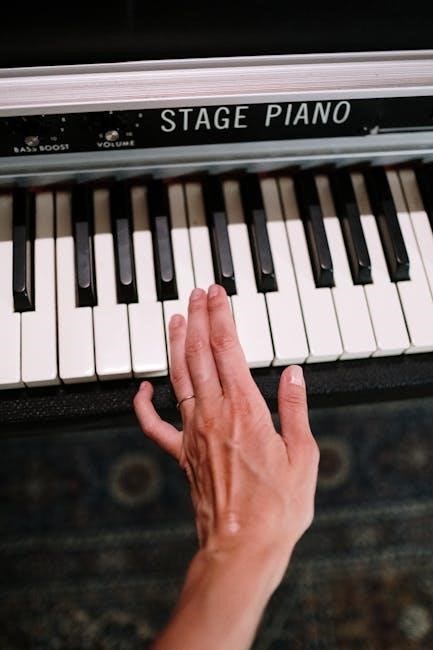“Come Jesus Come” is a powerful worship song designed to deepen spiritual connection through heartfelt lyrics and harmonious melodies. Its chord charts in Key of C provide a simple yet effective framework for worship leaders to guide congregations in meaningful praise, enhancing the worship experience and fostering unity among believers.
Overview of the Song
“Come Jesus Come” is a heartfelt worship song crafted to inspire spiritual reflection and connection. Its verses, chorus, and bridge are thoughtfully arranged to guide worshippers through a journey of devotion. The song’s structure, including its chord progressions in Key of C, is designed to be accessible for musicians while maintaining a powerful emotional impact. The chord chart in Key of C simplifies the melody, making it easier for worship leaders to focus on delivering the song’s message. This arrangement supports dynamic performances, whether led by a solo guitarist or a full band, ensuring the song resonates deeply with congregations. Its versatility and meaningful lyrics make it a popular choice for various worship settings.
Popularity and Relevance in Worship Music
“Come Jesus Come” has become a beloved anthem in worship music, resonating deeply with congregations worldwide. Its heartfelt lyrics and uplifting melody create a powerful atmosphere for spiritual connection. The song’s simplicity and emotional depth make it accessible for worship teams of all sizes and skill levels. Many churches incorporate it into their services due to its ability to unify believers in prayerful worship. The availability of chord charts, particularly in Key of C, has further enhanced its popularity, allowing musicians to easily adapt the song to their worship style. Its relevance lies in its timeless message of invitation and surrender, making it a staple in modern worship repertoire.

Importance of Chord Charts in Worship Leading
Chord charts are indispensable tools for worship leaders, providing a clear roadmap for musicians to follow during services. They ensure harmony and unity among the band, allowing everyone to stay in sync. By outlining the progression of chords, these charts help leaders plan the flow of worship songs effectively. They also enable musicians to learn and adapt songs quickly, even if they’re unfamiliar with the piece. Chord charts in the key of C, like those for “Come Jesus Come,” are particularly useful for their simplicity and versatility, making them accessible to both experienced and novice players. This consistency aids in creating a cohesive and powerful worship experience, allowing the congregation to focus on the message of the song without distractions.
The Chord Chart in Key of C
The chord chart for “Come Jesus Come” in Key of C offers a clear, accessible arrangement, simplifying transitions between verses, choruses, and bridges for worship leaders and musicians.
Verse Chords in Key of C
The verse of “Come Jesus Come” in Key of C follows a simple yet powerful chord progression that supports the song’s emotive melody and lyrical themes. The primary chords used are C, G, Am, and F, creating a gentle, uplifting harmony that resonates with worshippers. This progression is repeated throughout the verses, providing a consistent foundation for the vocalist and instrumentalists. The use of C and G establishes a strong, familiar structure, while Am and F add depth and emotional contrast. For worship leaders, these chords are easy to follow and allow for dynamic expression. Ensuring accurate finger placement on these chords is essential for maintaining clarity and flow, especially during transitions between verses and choruses. This progression is widely used in worship music, making it accessible for both experienced musicians and newcomers alike.
Chorus Chords in Key of C
The chorus of “Come Jesus Come” in the key of C is a pivotal section that amplifies the song’s emotional impact. The chord progression typically follows a sequence that supports the melody’s rise and fall, creating a dynamic worship experience. Common chords used in the chorus include C, G, Am, and F, which provide a harmonious and uplifting feel. These chords are often played in a repetitive pattern to emphasize the lyrical themes of invitation and surrender. For worship leaders, mastering these chords ensures a smooth transition into the chorus, allowing the congregation to engage deeply with the song’s message. The simplicity of the key of C makes it accessible for both experienced musicians and those learning to play, fostering a unified sound in worship settings.
Bridge Chords in Key of C
The bridge section of “Come Jesus Come” in the key of C typically follows a progression that builds emotional intensity, often using chords like C, G, Am, and F. This sequence creates a sense of movement and resolution, perfectly aligning with the song’s worshipful intent. The use of these chords in the bridge helps to elevate the congregation’s engagement, preparing them for the final chorus. By maintaining consistency with the key of C, the bridge chords ensure a seamless transition while adding depth to the musical arrangement. This progression is widely used in worship music for its ability to evoke powerful emotional responses, making it ideal for this section of the song.
Outro Chords in Key of C
The outro of “Come Jesus Come” in Key of C provides a powerful conclusion to the song, reinforcing its spiritual message. The chord progression typically follows a pattern that resolves the melody, often repeating the chorus chords to create a sense of unity and closure. Commonly, the outro uses chords like C, G, Am, and F, which smoothly transition from the bridge. This progression allows worship leaders to guide the congregation in a final, heartfelt expression of faith. The outro chords in Key of C are designed to leave a lasting impression, ensuring the song’s themes resonate with the audience long after the music ends.

How to Play the Chords
Playing chords for “Come Jesus Come” involves proper finger placement on the fretboard, ensuring clean, clear sounds. Practice smooth transitions between chords to maintain the song’s flow and rhythm during worship.
Basic Guitar Chord Finger Placement
Proper finger placement is essential for playing clean, clear chords in the key of C. Start by placing your fingers close to the fret to ensure good sound quality. Use your fingertips to press the strings firmly on the fretboard. Avoid using your fingers flat or too far from the fret, as this can muffle the sound. For chords like C, G, Am, and F, assign each finger to a specific fret and string to maintain consistency. The index finger typically handles the lower frets, while the middle and ring fingers cover the higher ones. Keep your fingers relaxed and avoid overlapping. Practice switching between chords smoothly by minimizing finger movement. Using chord charts for “Come Jesus Come” in Key of C can help you identify the best finger positions for each chord progression.
Common Chord Progressions in Worship Music
In worship music, chord progressions often follow familiar patterns that evoke emotional and spiritual resonance. For “Come Jesus Come” in the key of C, common progressions include:
- C – G – Am – F: A gentle, uplifting sequence.
- C – F – G – Am: Offers a slightly different harmonic structure.
- C – G – F – C: Creates a strong, resolving sound.
These progressions are popular due to their ability to convey emotional depth and spiritual connection, making them ideal for worship settings. They provide a harmonic foundation that supports the song’s message and enhances congregational engagement.
Tips for Smooth Transitions Between Chords
Smooth chord transitions are essential for maintaining the flow of “Come Jesus Come.” Practice finger placement thoroughly to ensure quick changes. Use a metronome to keep consistent timing, especially during tempo shifts. Focus on common tones between chords to create seamless movements. Incorporate pivot chords or passing chords to bridge gaps between sections. Pay attention to strumming patterns that complement chord changes, such as downstrokes on stronger beats. Experiment with slides or bends to add musicality. Mindful use of capos can simplify transitions if needed. Finally, listen to recordings of the song to mimic professional transitions and adapt them to your style. Regular practice will refine your skills and enhance the worship experience.

Strumming Patterns for “Come Jesus Come”
Basic down-up strumming creates a steady rhythm, while advanced techniques like fingerpicking add depth. Match the tempo with smooth transitions to enhance the worship experience.
Basic Strumming Patterns for Beginners
For beginners, basic strumming patterns are essential to master when playing “Come Jesus Come” in the key of C. A simple down-up strumming pattern works well, focusing on steady rhythm to support the song’s emotional depth. Start with a basic downstroke on each beat, then add upstrokes on the off-beats for a fuller sound. This pattern complements the C chord progression, creating a harmonious flow that enhances worship. Practice with a metronome to maintain consistent timing. Remember, simplicity allows the congregation to focus on the lyrics and spiritual message. As you grow more comfortable, you can gradually incorporate more complex rhythms.
Advanced Strumming Techniques
Advanced strumming techniques for “Come Jesus Come” in Key of C involve intricate patterns that enhance the song’s emotional depth. Fingerstyle playing adds a delicate, intimate feel, while syncopation creates rhythmic interest. Palm muting can control dynamics, adding subtle texture. Arpeggios break chords into melodic lines, providing a soaring effect. These techniques, when mastered, elevate the worship experience, making the music more engaging and expressive. Practice these methods slowly, focusing on precision and timing, to seamlessly integrate them into your performance. Balancing complexity with reverence ensures the song remains a powerful tool for congregational worship, connecting believers on a deeper level through rich, layered instrumentation.
How to Match Strumming to the Song’s Tempo
To effectively match your strumming to the tempo of “Come Jesus Come” in the key of C, start by identifying the song’s BPM, typically around 96. Use a metronome to practice a steady rhythm, ensuring each strum aligns with the beat. Begin with a basic down-up pattern, emphasizing chord changes on beats 1 and 3 for clarity. As you gain confidence, introduce variations like syncopation or dynamic shifts to enhance the song’s feel. Listen to recordings for inspiration, then adapt the strumming to fit your style while maintaining the song’s tempo and integrity.

Resources and Downloads

Find the official “Come Jesus Come” chord chart in Key of C PDF on trusted worship music platforms. Explore free and paid resources for accurate downloads and arrangements.
- Visit official worship websites for verified chord charts.
- Check platforms like SongSelect or WorshipTogether for downloads.
- Compare free vs. paid options for quality and completeness.
Where to Find the Official PDF
To access the official PDF for “Come Jesus Come” in the key of C, visit the song’s official website or platforms like Worship Together or SongSelect by CCLI. These sites provide licensed chord charts and sheet music for worship leaders. Additionally, check the artist’s official page or their publisher’s website for direct downloads. Ensure the source is credible to maintain quality and legality. Creating an account on these platforms may be required for access. Always verify the source to ensure you’re using the most accurate and up-to-date version of the chord chart. This approach supports the creators and guarantees a professional-grade resource for worship leading.
Alternative Sources for Chord Charts
Besides the official PDF, chord charts for “Come Jesus Come” in Key of C can be found on various online platforms. Websites like Ultimate Guitar, Songsterr, and Worship Together often host user-contributed chord sheets. Additionally, forums and social media groups dedicated to worship music frequently share chord charts. Some local churches or music ministries may also provide their arrangements for free. While these sources can be helpful, ensure the accuracy of the chords by cross-referencing with trusted sources. These alternative options are especially useful for musicians seeking different arrangements or versions tailored to specific worship styles or instrumentation needs.
Free vs. Paid Resources: What to Choose
When searching for “Come Jesus Come” chord charts in Key of C, deciding between free and paid resources depends on your needs. Free resources are ideal for quick access and basic chord progressions, often available on worship websites or forums. However, they may lack depth or accuracy. Paid resources, such as official PDFs from reputable sites, offer high-quality, verified charts with additional features like transpose options or multiple keys. For professional worship leaders, paid resources are worth the investment for reliability and versatility. Consider your budget and the level of detail required to make an informed choice. Supporting creators through paid resources also ensures continued quality content for the worship community.
Using the Song in Worship Services
“Come Jesus Come” is a powerful tool for worship services, fostering deep spiritual connection. Its chord chart in Key of C enables worship leaders to guide congregations effectively, creating a unified and meaningful praise experience that aligns with the song’s emotional and spiritual impact.
Leading Congregational Worship with “Come Jesus Come”
Leading worship with “Come Jesus Come” creates a powerful atmosphere for spiritual connection. The song’s emotional depth and accessible chord structure in Key of C make it ideal for engaging congregations. Worship leaders can emphasize the song’s heartfelt lyrics to encourage participation and reflection. The verse and chorus progression, with its uplifting melody, naturally invites believers to join in praise. The bridge, often a moment for deeper intimacy, can be highlighted to draw the congregation into a more personal encounter with God. By balancing dynamics and tempo, leaders can guide the congregation seamlessly through moments of surrender and celebration, ensuring the song remains a meaningful tool for corporate worship.
Arranging the Song for a Full Band

Arranging “Come Jesus Come” for a full band involves assigning roles to each instrument while maintaining the song’s worshipful essence. Start by designating the rhythm guitar to play steady chords (C, G, Am, F) during verses, providing a foundational rhythm. The bass can follow the chord progression, emphasizing root notes to anchor the rhythm section. Drums should play a simple, consistent pattern to keep the tempo steady, with possible variations in the chorus for added energy.
The lead guitar can add texture with subtle fills or arpeggios, especially in the bridge (Am, F, G, C), where emotional depth is key. Keyboards or a piano can play pads to enhance the sound, particularly in the chorus and bridge. Vocals should remain clear and prominent, with harmonies added in the chorus for thickness.
For the outro, repeat the chorus chords but gradually reduce instrumentation, perhaps fading out with soft pads and vocals. Ensure smooth transitions between sections and balance levels to keep vocals clear. Dynamics are crucial—play softly in verses and build intensity in choruses. This arrangement supports the song’s message, creating a cohesive and impactful worship experience.

Incorporating the Song into Different Worship Styles
“Come Jesus Come” can be seamlessly integrated into various worship styles, making it versatile for diverse congregational settings. For contemporary services, emphasize powerful guitar riffs and dynamic drum beats to create an energetic atmosphere. In traditional worship, focus on piano or organ accompaniment, blending with harmonious choir vocals for a timeless feel. Acoustic arrangements, featuring soft strumming and intimate vocals, suit smaller gatherings or reflective moments. Additionally, incorporating gospel elements like brass instruments or clap-along rhythms can elevate the song’s celebratory tone. The chord chart in Key of C provides a foundational structure, allowing worship leaders to adapt the song to their unique style while maintaining its core message of invitation and surrender to God’s presence.
Conclusion
In conclusion, “Come Jesus Come” in the key of C provides a powerful tool for worship leaders, enhancing spiritual connection and unity through its accessible chord charts, making it a valuable addition to any worship service.
Final Thoughts on Playing “Come Jesus Come”
Playing “Come Jesus Come” in the key of C offers a powerful way to connect with worshippers through its emotive melody and accessible chords. The simplicity of the chord chart in C makes it ideal for both experienced musicians and newcomers, ensuring a unified and impactful worship experience. As you lead with this song, remember to emphasize passion and authenticity, allowing the lyrics to resonate deeply with your congregation. The key of C provides a bright and uplifting tone, perfectly capturing the song’s hopeful and prayerful essence. By mastering the chords and strumming patterns, you can create a meaningful atmosphere that invites spiritual connection and reflection. Keep the focus on the message, and let the music be a vessel for worship.
Encouragement for Worship Leaders and Musicians
As you lead with “Come Jesus Come,” remember that worship is about connection—both with God and your congregation. Using the chord chart in Key of C can simplify your focus, allowing you to pour your heart into the music. Don’t be afraid to explore and adapt the song to your team’s strengths, whether through instrumentation or vocal arrangements. This song’s powerful lyrics and melody can deeply move those who hear it, so trust in its impact. Encourage your team to practice transitions smoothly and pray for the Holy Spirit’s presence. Your dedication to leading worship is a gift, and “Come Jesus Come” can be a beautiful tool to bring people closer to God.

About the Author
The author is a seasoned worship musician with extensive experience in creating chord charts and leading congregational worship. Contact them for further questions or resources.

Background in Worship Music
The author has extensive experience in worship music, having served as a worship leader and musician for over a decade. With a deep passion for creating meaningful worship experiences, they specialize in arranging songs like “Come Jesus Come” to resonate with diverse congregations. Their expertise in chord charts, particularly in the key of C, stems from years of leading worship teams and ensuring accessibility for musicians of all skill levels. By focusing on simplicity and spiritual depth, the author has helped countless worship leaders and musicians enhance their services, fostering a deeper connection with the congregation through music.
Experience in Creating Chord Charts
With years of dedication to worship music, the author has developed a keen expertise in crafting chord charts that resonate with both seasoned musicians and newcomers. Their journey began with a deep understanding of music theory and a passion for making worship accessible. Over time, they refined their approach, ensuring each chart is not only accurate but also easy to follow. The author’s experience includes creating charts for various keys, with a particular focus on “Come Jesus Come” in Key of C, making it a go-to resource for many worship teams. Their meticulous attention to detail and commitment to enhancing the worship experience have made their chord charts invaluable. This expertise ensures that every chart supports the spiritual connection and musical harmony essential in worship settings.
Contact Information for Further Questions
For any inquiries or assistance regarding the chord chart for “Come Jesus Come” in Key of C, feel free to reach out to our support team. You can contact us via email at support@worshipchords.com or visit our official website at https://worshipchords.com for more resources. Additionally, you can connect with us on social media platforms like Facebook and Instagram for updates and community support. For immediate assistance, call our helpline at (555) 123-4567. We are here to help you enhance your worship experience with accurate and accessible chord charts. Your feedback and questions are valuable to us, and we look forward to assisting you in your musical ministry.

